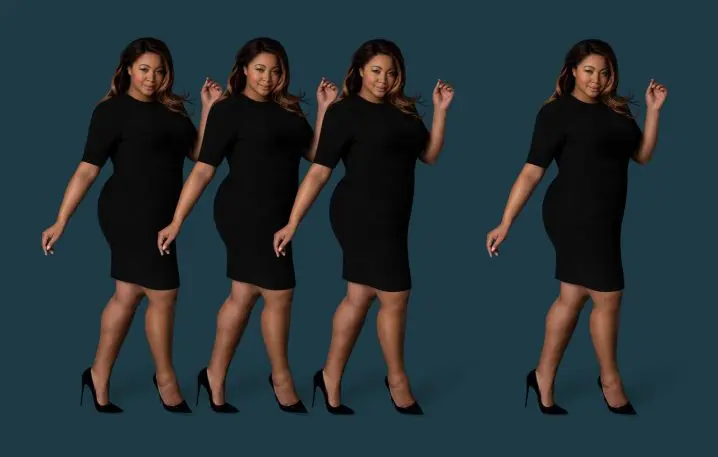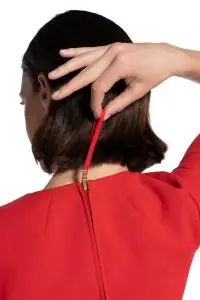If you fall in love with a black shift dress at a department store, it will likely come in just nine sizes, between 0 and 16. If your torso is too long or your bust is too big to squeeze into one of these options, too bad. Pick another dress.
A startup called Laws of Motion, which launches today, wants to totally overhaul this traditional sizing model. “Fashion sizing is antiquated, and hasn’t had a real update in decades,” says Carly Bigi, Laws of Motion’s founder and CEO. “My goal was to use data science to create perfect-fitting women’s clothing at scale.”
For years, the fashion industry has approached sizing in the same way. A brand will create a pattern based on the body of one woman, known as a fit model, and then size up and down an inch to create larger or smaller sizes. Since it is expensive for brands to buy inventory in a wide range of sizes, most brands create less than a dozen size options, then expect the customer to find the one that comes closest to their body shape. “The system works great if you happen to have the exact proportions of the fit model,” says Bigi. “But most women don’t.”
There has been some movement toward inclusive sizing over the past few years. Brands like Universal Standard, Good American, and Christian Siriano now make well-designed, high-end clothes that extend across a wider spectrum of sizes, sometimes as broad as 00 to 40. But what sets Laws of Motion apart is that it goes beyond simply creating the same dress in a range of sizes–from 00 to 22. It also takes into account smaller variations in body shapes, including waist and bust measurements.

How it works
Laws of Motion crunched a million data points gathered from 10,000 women to better understand the size and shape variations of their bodies. It now offers 99 sizes that will fit women sizes 00 to 24. Within a typical brand, I would pick a dress in a size six. But at Laws of Motion, there would be eight different micro-sizes within the size six range, ensuring that I have a much more tailored fit. For instance, the algorithm might assess that I need smaller shoulder width, or a larger bust than I might with a traditional size six. “I’m interested in the multi-variability of women’s bodies, like how the length of a woman’s arm impacts her shoulder width,” says Bigi, whose first two hires were data scientists, rather than fashion designers. “We think of inclusivity as more than just the number of sizes, but also the shapes within those sizes.”
Laws of Motion is debuting with a single product, a $195 sheath dress that comes in three colors: navy, black, and red. But the plan is to release a steady stream of other clothes that will build on the data gathered from this pilot outfit. Bigi wanted to launch with a sheath because it’s a versatile silhouette that is a staple in many women’s wardrobes. But it’s also a difficult dress to nail: Ideally, it would hug the curves of the body, but not be too tight. “We figured that if we could create a perfectly fitting sheath dress, we could take on anything else in a woman’s closet,” Bigi says.

On-demand manufacturing
Besides its unique sizing model, Laws of Motion stands out for its efficient manufacturing. Bigi points out that it would be impossible for the brand to hold inventory in such a wide range of sizes. Two years ago, after Bigi graduated from Columbia Business School, she raised a pre-seed $1 million round, which she used to build an entirely automated, on-demand manufacturing system in a Brooklyn factory. As soon as a customer places an order on the website, a digital file with details about their measurements is sent to the factory, where the fabric is cut by laser, sewn by machine in exactly 10 minutes flat. It is then shipped to the customer, who will receive it within days. This approach has the additional benefit of being better for the environment because it means no unsold inventory, which is a huge contributor to waste in the fashion industry.
While many consumers are unsatisfied with the current sizing approach in fashion, it is nonetheless a system they’ve become accustomed to. Bigi realized that it would be a challenge to introduce women to an entirely new approach to sizing, so she’s tried to simplify the process as much as possible. On the website, customers start off by answering a list of simple questions that should take less than a minute. Questions include height, weight, age, ethnicity, bra, and jean size. When you’re done, the information is saved in the system and maps to one of the brand’s 99 different sizes.
The fit
I tested out the entire process a week before Laws of Motion launched. When I answered the questions, the brand gave me a little insight into my micro-size for the sheath dress. Compared to a typical off-the-rack dress, Laws of Motion would create a dress that had a more tailored bust, while providing more space in the waist and hips.

But in the end, it didn’t matter, because the dress fit like a glove. When I tried it on, it seemed better adapted to my body than a typical sheath dress. It had several more darts at the waist and the bust than you might expect in a regular dress, and in my case, they hit at exactly the right spots, creating a tapered look. It felt very close to a bespoke dress you might get at a tailor.
With this new sizing model and manufacturing system, Bigi says the brand is developing a range of other garments that will be modern takes on classic silhouettes. (Think: jeans, oxford shirts, and suits.) Bigi says it will take time to understand how how the 99 sizes will play out in these other garments, since the team will have to consider how all the variations in women’s bodies influence the fit in these silhouettes. For now, customers can see how they feel in the brand’s sheath dress. It drops on the Laws of Motion website today.
Recognize your brand’s excellence by applying to this year’s Brands That Matter Awards before the early-rate deadline, May 3.